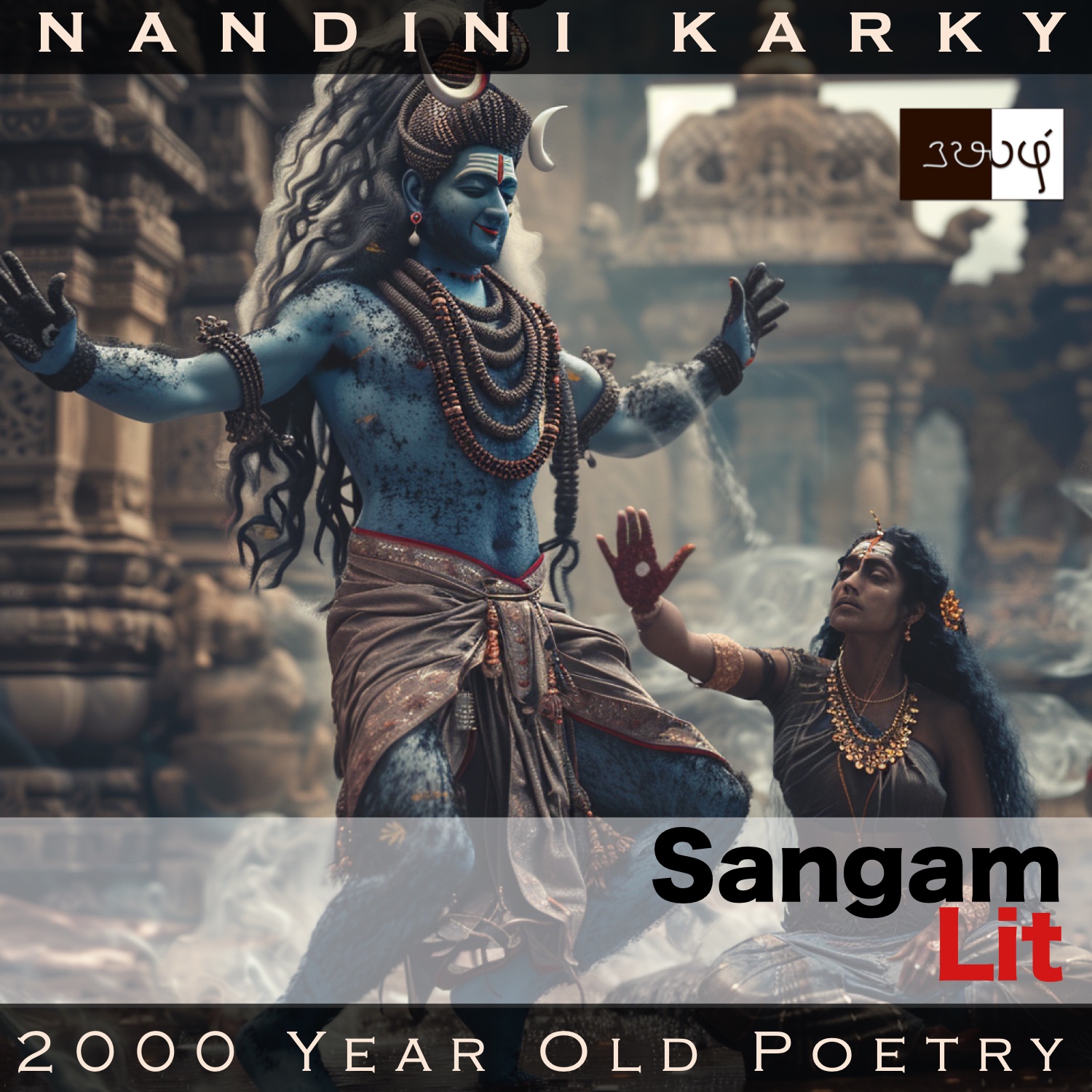Podcast: Play in new window | Download
Subscribe: Apple Podcasts | Spotify | Amazon Music | Android | iHeartRadio | TuneIn | RSS | More
In this episode, we perceive the roles of a god and his consort, as depicted in Sangam Literary work, Kalithogai 1, penned by an anonymous poet. Kalithogai is a collection of musical verses in the ‘Aham’ or ‘Inner life’ classification of Sangam Literature. This first verse is a prayer song, believed to be added to this collection at a later period.

ஆறு அறி அந்தணர்க்கு அரு மறை பல பகர்ந்து,
தேறு நீர் சடைக் கரந்து, திரிபுரம் தீ மடுத்து,
கூறாமல் குறித்ததன் மேல் செல்லும் கடுங் கூளி
மாறாப் போர், மணி மிடற்று, எண் கையாய்! கேள், இனி:
படு பறை பல இயம்ப, பல் உருவம் பெயர்த்து நீ,
கொடுகொட்டி ஆடுங்கால், கோடு உயர் அகல் அல்குல்,
கொடி புரை நுசுப்பினாள் கொண்ட சீர் தருவாளோ?
மண்டு அமர் பல கடந்து மதுகையால் நீறு அணிந்து,
பண்டரங்கம் ஆடுங்கால், பணை எழில் அணை மென் தோள்,
வண்டு அரற்றும் கூந்தலாள் வளர் தூக்குத் தருவாளோ?
கொலை உழுவைத் தோல் அசைஇ, கொன்றைத் தார் சுவல் புரள,
தலை அங்கை கொண்டு, நீ காபாலம் ஆடுங்கால்,
முலை அணிந்த முறுவலாள் முன் பாணி தருவாளோ?
என ஆங்கு
பாணியும், தூக்கும், சீரும், என்று இவை
மாண் இழை அரிவை காப்ப,
ஆணம் இல் பொருள் எமக்கு அமர்ந்தனை ஆடி.
Here’s an invocation song that contains many mythical details about God Siva and his companion Goddess. The verse can be translated as follows:
“You offered precious scriptures to priestly scholars, who had attained the path of righteousness; You hid clear waters in your matted braids; You set the land of ‘Tripuram’ on fire; You are one who transcends the limits of words; You waged a fearsome battle with your army that knows not retreat; O lord with a sapphire neck and eight arms, listen to what I have to say!
When drums many resound, taking many different forms, as you perform the ‘Kodukatti’ dance, will she, the one with uplifted, wide loins, and a waist, akin to a vine, render the final ‘seer’ beat?
Crossing many fierce battlefields with strength, as you perform the ‘Paandarangam’ dance, adorned with ash, will she, the one with beautiful, bamboo-like soft arms and bee-buzzing tresses, render the growing, intermittent ’thookku’ beat?
When the skin of the killer tiger you wear sways and the golden shower garland twirls around your shoulders, as you perform the ‘Kapaalam’ dance, holding a head in your palm, will she, the one with smiles, akin to wild jasmines, render the initial ‘paani’ beat?
And so, with the initial, intermittent and final beats, as the maiden with well-etched ornaments protects, on us, who have no one to love, you render your grace, dancing. “
Let’s explore the details presented in this verse. The fact is that there was no tradition of starting a collection of verses with a prayer song in Sangam times, for they preferred to delve into the facets of inner life without much ado. And so, although we have not yet entered the actual doors of Kalithogai, this verse can be imagined as the opening of the outer gate that people from a later era have constructed to protect their ideology of a supreme power.
Delving into the verse, the words are addressed to God Siva, and offers insights about this god. The first note is about how he gave the scriptures to priests, who were on the path of righteousness. The parallel from another religion that strikes me now is how according to the Old Testament, God was supposed to have given the Ten commandments to Moses. Returning to the God in this verse, then there’s an account of how he holds the waters of the Ganges in his matted locks of hair. The third mythical story is about how this God burnt down the land of the demons called as ‘Tripuram’. This description ends with the familiar sketch of this God having a sapphire-hued neck and eight arms, which we notice especially in the dancing version called ‘Nataraja’.
After the description, the poet beckons the god to listen to him and then describes three kinds of dance performed by the celestial warrior. These are ‘Kodukatti’, in which God Siva takes many forms and dances as drums resound, then the ‘Paandarangam’, in which he dances smeared with the ash of the demons, whom he conquered, and finally, the ‘Kapaalam’, in which he dances holding the head of the vanquished in his palm, as a golden shower flower garland, swirls around his shoulders, and the tiger skin he wears sways around.
What the poet adds to these dances is the unique aspect here! The poet describes the Goddess consort of this God as having a vine-like waist, bamboo-like arms, bee-buzzing tresses and a smile like that of blooming wild jasmines. The thing to note here is how the description of this mythical, celestial entity matches that of the lady, or the female protagonist of Sangam literature, whom we have met with in many, many Aham verses. After this earthy description, the poet asks if this Goddess is the one who keeps the initial, intermittent and final beats as this great God dances away, and ends in wonder about the love rendered by this God on the worshippers, amidst his fury and rampage in the battlefield.
And so, we see how God and his consort are modelled on the lines of the man and his lady, wherein one, brimming with fury and a sense of duty, while the other is the epitome of peace and calm, the protector and healer. It is in the perfect duet of this masculine and feminine that the world revolves in the rhythm of balance, implies this invocation song at the beginning of our journey into Kalithogai, an uproarious and spirited celebration of love!




Share your thoughts...